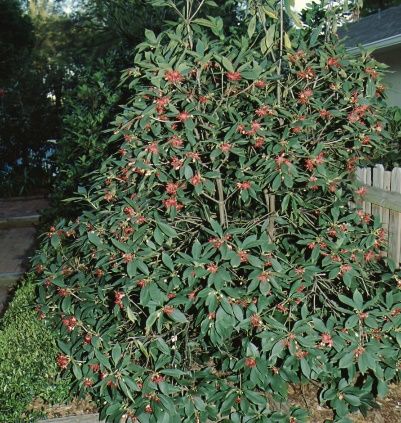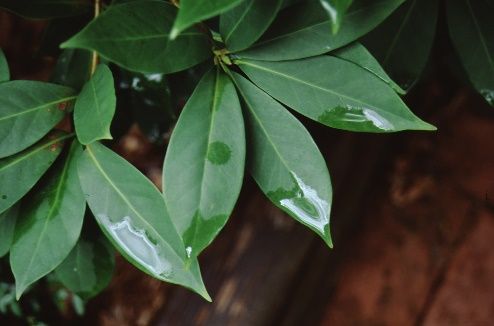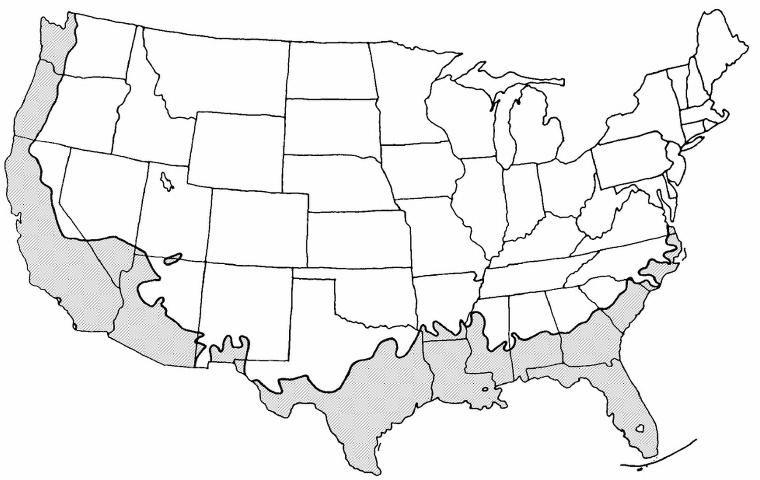Introduction
This rapidly growing, evergreen, Florida native shrub has olive green leaves and reddish-purple, starry, 2 inch flowers. The many slender branches of Florida anise droop to the ground, giving a rounded, open canopy in the shade, ideal for natural settings, or in sunny locations it can be pruned into dense hedges or windbreaks. The small, somewhat showy, maroon flowers appear in spring and are followed in late summer to fall by star-shaped, many-seeded pods which cling to the stems. The leaves of Florida anise give off a distinctive odor when bruised or crushed.

Credit: Edward F. Gilman, UF/IFAS

Credit: Edward F. Gilman, UF/IFAS

Credit: Edward F. Gilman, UF/IFAS
General Information
Scientific name: Illicium floridanum
Pronunciation: ill-LISS-see-um flor-rid-DAY-num
Common name(s): Florida anise tree, Florida anise
Family: Illiciaceae
Plant type: shrub
USDA hardiness zones: 8 through 10 (Figure 4)
Planting month for zone 7: year round
Planting month for zone 8: year round
Planting month for zone 9: year round
Planting month for zone 10: year round
Origin: native to Florida
Invasive potential: not known to be invasive
Uses: container or above-ground planter; hedge; espalier; screen; foundation; border
Availability: somewhat available, may have to go out of the region to find the plant

Credit:
Description
Height: 10 to 15 feet
Spread: 6 to 10 feet
Plant habit: oval
Plant density: dense
Growth rate: moderate
Texture: medium
Foliage
Leaf arrangement: alternate
Leaf type: simple
Leaf margin: undulate
Leaf shape: ovate
Leaf venation: none, or difficult to see
Leaf type and persistence: fragrant
Leaf blade length: 2 to 4 inches
Leaf color: green
Fall color: no fall color change
Fall characteristic: not showy
Flower
Flower color: red
Flower characteristic: spring flowering; unpleasant fragrance
Fruit
Fruit shape: irregular
Fruit length: 0.5 to 1 inch
Fruit cover: dry or hard
Fruit color: green
Fruit characteristic: inconspicuous and not showy
Trunk and Branches
Trunk/bark/branches: typically multi-trunked or clumping stems; can be trained to grow with a short, single trunk; not particularly showy
Current year stem/twig color: green
Current year stem/twig thickness: medium
Culture
Light requirement: plant grows in part shade/part sun
Soil tolerances: acidic; slightly alkaline; sand; loam; clay;
Drought tolerance: moderate
Soil salt tolerances: poor
Plant spacing: 36 to 60 inches
Other
Roots: sprouts from roots or lower trunk
Winter interest: no special winter interest
Outstanding plant: not particularly outstanding
Pest resistance: no serious pests are normally seen on the plant
Use and Management
Florida anise grows well in sun or shade, but thins out in the shade. Florida anise appreciates rich soil and ample moisture but will easily survive harsher conditions. It is an easy-to-grow, pest-free shrub. Once established it will need watering only during long periods of drought and pruning once a year to maintain its shrub form. It can be pruned and trained into a small, multi-trunked or single-trunked tree.
The cultivar 'Album' has white flowers.
Propagation is by cuttings or layering.
Pests and Diseases
No pests or diseases are of major concern.